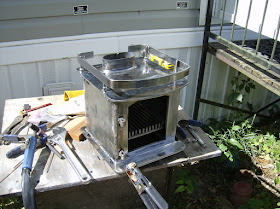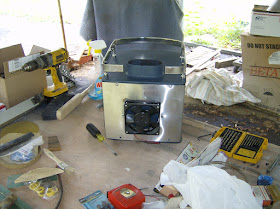Is your fuel clean? Are you sure?
Really sure? Want to find out when the waves are sloshing it around in your tanks, stirring it up? Tho bugs and decomposition products can foul your tank with even the cleanest fuel, Steve and Lulu aboard
s/v Siempre Sabado get a head start by making sure the fuel going into their tank
really is clean:
The beauty of diesels is that they don't ask for much. Plenty of air and nice clean fuel is about it. The problem is that they are quite picky about their fuel being CLEAN!
The following is definitely NOT an original idea on my part. I blatantly stole it from my friend (that I've never met) Wojtek, who sails the Westsail 28 "Namaste". I recently did a blog where I was complaining about my over-the-top fuel filtration system and said I was going to get rid of the Racor 215R filter unit that I had been using as a secondary filter. Wojtek responded with the following comment:
Steve, if I can suggest, stick with this old Racor. You never know when you might need it but there is a better thing you can do with it.
I have reused my old Racor after installing dual primaries. It is sitting on the port side of the lazarette, coupled with a small electric fuel pump. Every drop of fuel that goes into Namaste's tank is squeezed thru the 2 micron filter. Have I mentioned that I haven't had to even flick to the second primary since the setup?
Cheers,
Wojtek
He then included a link to some pictures of the set-up he made for Namaste. Well, I know a good idea when I see one. So, instead of dumping the $110 filter unit and the $30/each filter canisters, I made a copy of Namaste's filtration set-up for Siempre Sabado.
Can't remember what I paid for the nylon cutting board that it's all mounted on but the fuel pump cost about $25.00, the hose was less than $3.00, the toggle switch and various fittings were in my junk "good stuff" bins.
I transferred about 20 gallons of diesel to the main tank today using the filtration system. It takes awhile as the pump only pulls the fuel through the filter at about a liter per minute. But there was absolutely NO mess and I know that the fuel I put into the tank today is so clean that my 30 micron primary filters will pretty much have nothing to do.< Our usual practice is to take our jerry jugs to a fuel dock in the dinghy and then fill our main tank from the jugs. We haven't pulled up to a fuel dock since we were in Santa Barbara a year ago. The main tank is 39 gallons so, even if she was bone dry, it would only take 2 trips to the pumps to fill her back up. Well, then one more to fill the jerry jugs for reserve. Doesn't really matter how slow the filter/pump empties the jugs since we're not tying up a fuel dock while we're doing it. So, thanks, Wojtek for the idea and for the advice.
















































